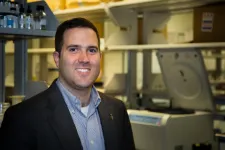(Press-News.org) DALLAS (SMU) - An international team of paleontologists has identified a new genus and species of hadrosaur or duck-billed dinosaur, Yamatosaurus izanagii, on one of Japan's southern islands.
The fossilized discovery yields new information about hadrosaur migration, suggesting that the herbivors migrated from Asia to North America instead of vice versa. The discovery also illustrates an evolutionary step as the giant creatures evolved from walking upright to walking on all fours. Most of all, the discovery provides new information and asks new questions about dinosaurs in Japan.
The research, "A New Basal Hadrosaurid (Dinosauria: Ornithischia) From the latest Cretaceous Kita-ama Formation in Japan implies the origin of Hadrosaurids," was recently published in Scientific Reports. Authors include Yoshitsugu Kobayashi of Hokkaido University Museum, Ryuji Takasaki of Okayama University of Science, Katsuhiro Kubota of Museum of Nature and Human Activities, Hyogo and Anthony R. Fiorillo of Southern Methodist University.
Hadrosaurs, known for their broad, flattened snouts, are the most commonly found of all dinosaurs. The plant-eating dinosaurs lived in the Late Cretaceous period more than 65 million years ago and their fossilized remains have been found in North America, Europe, Africa and Asia.
Uniquely adapted to chewing, hadrosaurs had hundreds of closely spaced teeth in their cheeks. As their teeth wore down and fell out, new teeth in the dental battery, or rows of teeth below existing teeth, grew in as replacements. Hadrosaurs' efficient ability to chew vegetation is among the factors that led to its diversity, abundance and widespread population, researchers say.
The Yamatosaurus' dental structure distinguishes it from known hadrosaurs, says Fiorillo, senior fellow at SMU's Institute for the Study of Earth and Man. Unlike other hadrosaurs, he explains, the new hadrosaur has just one functional tooth in several battery positions and no branched ridges on the chewing surfaces, suggesting that it evolved to devour different types of vegetation than other hadrosaurs.
Yamatosaurus also is distinguished by the development of its shoulder and forelimbs, an evolutionary step in hadrosaurid's gait change from a bipedal to a quadrupedal dinosaur, he says.
"In the far north, where much of our work occurs, hadrosaurs are known as the caribou of the Cretaceous," says Fiorillo. They most likely used the Bering Land Bridge to cross from Asia to present-day Alaska and then spread across North America as far east as Appalachia, he says. When hadrosaurs roamed Japan, the island country was attached to the eastern coast of Asia. Tectonic activity separated the islands from the mainland about 15 million years ago, long after dinosaurs became extinct.
The partial specimen of the Yamatosaurus was discovered in 2004 by an amateur fossil hunter in an approximately 71- to 72-million-year-old layer of sediment in a cement quarry on Japan's Awaji Island. The preserved lower jaw, teeth, neck vertebrae, shoulder bone and tail vertebra were found by Mr. Shingo Kishimoto and given to Japan's Museum of Nature and Human Activities in the Hyogo Prefecture, where they were stored until studied by the team.
"Japan is mostly covered with vegetation with few outcrops for fossil-hunting," says Yoshitsugu Kobayashi, professor at Hokkaido University Museum. "The help of amateur fossil-hunters has been very important."
Kobayashi has worked with SMU paleontologist Tony Fiorillo since 1999 when he studied under Fiorillo as a Ph.D. student. They have collaborated to study hadrosaurs and other dinosaurs in Alaska, Mongolia and Japan. Together they created their latest discovery's name. Yamato is the ancient name for Japan and Izanagi is a god from Japanese mythology who created the Japanese islands, beginning with Awaji Island, where Yamatosaurus was found.
Yamatosaurus is the second new species of hadrosaurid that Kobayashi and Fiorillo have identified in Japan. In 2019 they reported the discovery of the largest dinosaur skeleton found in Japan, another hadrosaurid, Kamuysaurus, discovered on the northern Japanese island of Hokkaido.
"These are the first dinosaurs discovered in Japan from the late Cretaceous period," Kobayashi says. "Until now, we had no idea what dinosaurs lived in Japan at the end of the dinosaur age," he says. "The discovery of these Japanese dinosaurs will help us to fill a piece of our bigger vision of how dinosaurs migrated between these two continents," Kobayashi says.
INFORMATION:
Researchers at the Pritzker School of Molecular Engineering (PME) at the University of Chicago have designed a completely novel potential treatment for COVID-19: nanoparticles that capture SARS-CoV-2 viruses within the body and then use the body's own immune system to destroy it.
These "Nanotraps" attract the virus by mimicking the target cells the virus infects. When the virus binds to the Nanotraps, the traps then sequester the virus from other cells and target it for destruction by the immune system.
In theory, these Nanotraps could also be used on variants of the virus, leading to a potential new way to inhibit the virus going forward. Though the therapy remains in early stages of testing, the researchers envision it could be administered ...
In a paper published in the journal Scientific Reports, researchers from Surrey investigated whether the daily consumption of a prebiotic food supplement could improve overall wellbeing in a group of 18 to 25 year-olds. The study found that those who received a daily dose of prebiotics improved mental wellbeing by reducing anxiety levels and had better gut health than the control group.
Researchers studied a group of 64 healthy female participants with no current or previous clinical diagnoses of anxiety. Participants received either a daily dose of the prebiotic galacto-oligosaccharides (GOS) or a placebo for 28 days.
All those involved in the trial completed surveys about their health experiences, including mood, anxiety and sleep quality and provided a stool sample ...
New studies from the Center for Advanced Bioenergy and Bioproducts Innovation (CABBI) shed more light on the economic and environmental costs of mandates in the Renewable Fuels Standard (RFS), a federal program to expand the nation's biofuels sector.
Researchers said the studies indicate the need to adopt more targeted policies that value the environmental and ecosystem benefits of perennial bioenergy crops over cheaper options -- and provide financial incentives for farmers to grow them.
The RFS was issued in 2005 and updated through the Energy Independence and Security Act of 2007 ...
MEMPHIS, Tenn. - For the first time in published literature, Le Bonheur Children's Hospital and University of Tennessee Health Science Center (UTHSC) researchers showed that a variety of white blood cells known as eosinophils modify the respiratory barrier during influenza A (IAV) infection, according to a recent paper in the journal Cells. This research could have implications in understanding SARS-CoV-2 (COVID-19) infection in asthmatic patients.
The Le Bonheur/UTHSC study found that eosinophils immunomodulate airway epithelial cells during IAV infection, helping to neutralize the virus and ...
The legend of the "kraken" has captivated humans for millennia. Stories of deep-sea squid dragging sailors and even entire ships to their doom can be found in everything from ancient Greek mythology to modern-day movie blockbusters. It is therefore ironic that the species that inspired these stories, the giant squid Architeuthis dux, is camera-shy. In fact, filming this species in the wild has proven an insurmountable challenge for countless scientists, explorers, and filmmakers. To date, only one scientist, Dr. Edith Widder of the Ocean Research & Conservation Association, has repeatedly caught a live giant squid on camera. In a new study, Dr. Widder and her colleagues have finally revealed the secrets behind their success. This study, which is free to access, also ...
An Academic Analytics Research Center (AARC) study published in the journal Scientometrics found that senior faculty (scholars who earned their terminal degree 30 or more years ago) research publication activity exceeded expectations based on age cohort population for book chapters and book publications, and senior scholars largely kept pace in terms of journal article publications. "Across all disciplines, senior faculty may be uniquely positioned to invest their time in a longer-term publication effort, shifting their research focus to the review and synthesis of ideas through the publication of books and chapters," said AARC Senior Researcher and Co-Author of the study, Bill Savage, Ph.D.
The study explored the publishing activity of 167,299 unique faculty members at American ...
Aromatics are major building blocks of polymers, or plastics, that turn up as everything from PET bottles for water to breathable, wrinkle-resistant polyester clothing. These petrochemicals comprise a specialized, value-added sector of the energy industry. The process for refining crude oil into useful aromatic streams for derivative use often involves the usage of a catalyst to facilitate chemical reactions. Among the various types of catalysts, many are zeolites - porous aluminosilicates - such as ZSM-5, a unique synthetic zeolite prolifically used in the upgrading of chemicals in alkylation and isomerization. Petrochemicals producers are constantly looking to minimize overhead costs to weather the volatility in commodity markets and provide a competitive end product ...
NEWPORT NEWS - Nuclear physicists have made a new, highly accurate measurement of the thickness of the neutron "skin" that encompasses the lead nucleus in experiments conducted at the U.S. Department of Energy's Thomas Jefferson National Accelerator Facility and just published in Physical Review Letters. The result, which revealed a neutron skin thickness of .28 millionths of a nanometer, has important implications for the structure and size of neutron stars.
The protons and neutrons that form the nucleus at the heart of every atom in the universe help determine each atom's identity and properties. Nuclear physicists are studying different nuclei to learn more about how these protons and neutrons act inside the nucleus. The Lead Radius Experiment collaboration, called PREx (after ...
WASHINGTON, April 27, 2021 -- A wide variety of portable and wearable electronics have become a large part of our daily lives, so a group of Stanford University researchers wondered if these could be powered by harvesting electricity from the waste heat that exists all around us.
Further inspiration came from a desire to ultimately fabricate energy converting devices from the same materials as the active devices themselves, so they can blend in as an integral part of the total system. Today, many biomedical nanodevices' power supplies come from several types of batteries that must be separated from the active portion of the systems, which is not ...
WASHINGTON, April 27, 2021 -- The AstraZeneca COVID-19 vaccine is suspected of being linked to a small number of deep vein thrombosis (DVT) cases, which recently emerged within Europe as millions of people received vaccinations. This led several countries to suspend AstraZeneca injections and investigate the causal links to DVT.
Researchers within Europe teamed up to explore a hypothesis that pausing AstraZeneca vaccinations, even for a short duration, could cause additional deaths from the faster spread of COVID-19 within a population of susceptible ...






